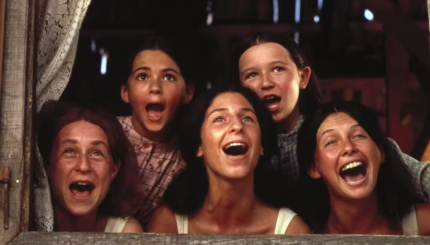The following article looks at the early career of the writer-director-actor Woody Allen and traces his growing reliance on Jewish humor, which would reach its full expression later in his career. Reprinted with permission from American-Jewish Filmmakers: Traditions and Trends (University of Illinois Press).
Woody Allen’s career represents a virtual case history in coming to terms with tradition, with the search for an appropriate personal model of artistic creation sifted through a set of circumstances characteristic of a large portion of American Jewry. His films participate in the stream of American-Jewish art and literature that uses the structure of the bildungsroman [a style of novel focusing on the main character’s personal development] to examine the emerging, maturing self and its relation to the world. His films, further, rely heavily upon the classic characteristics of Jewish humor and target aspects of popular culture.
Allen’s cinema, however, participates little in the search for social justice, a point for which he has been criticized, most often by Jewish critics. Instead, he reaches beyond the moment for larger social and religious truths. In this respect, Allen’s cinema draws as much on other traditions as on Jewish ones, particularly relying upon the tradition of European art cinema exemplified for Allen, as for most audiences, by Bergman and Fellini.
Cinema as Judaism
Allen archetypically represents the American-Jewish artist in his reproduction of the absent tradition of American-Jewish art: Judaism. In fact, Judaism is the structuring absence of his mature films; his cinema is a constant working out of this missing link, a continual search for a substitute for Judaism. Jewish artists often manifest this absence through the search for social justice or the participation in popular lifestyle trends.
For Allen, however, the cinema itself substitutes for Judaism. Although he began his film career by humorously parodying earlier films and film forms, his career has gradually explored the place of movies within a complete, meaningful life. This life will be lived in the predominant settings associated with American Jewry–urban America, often within the world of show business–but meaning will be derived from a search for the transcendent found in the movies.
Allen’s search for traditions is also a matter of coming to terms with influences, many of which derive from Jewishness, although he borrows from other significant traditions as well. In addition to the tradition of European art cinema, he draws upon the tradition of American silent comedy, especially the works of Charlie Chaplin, Buster Keaton, and Harold Lloyd. In fact, Allen’s cinema progresses precisely by the degree to which he gradually abandons the established physical traditions of comedy in favor of a metaphysical approach exemplified by Bergman and Fellini.
The Schlemiel
Allen’s reproduction of the image of the little man owes a specific debt to Chaplin, Keaton, and Lloyd, as well as to the schlemiel figure. The little man at odds with his environment remains an apt metaphor for the Jewish experience in history, but it persists as an equally potent contemporary symbol and is an often-used comic device.
Allen’s combination of the Jewish aspects of the schlemiel with physical characteristics of the silent clowns presents an image of a man eternally bewildered by a hostile universe. In this respect, Allen typically reproduces the basic humor in the situations of classic comedies: of Charlie Chaplin’s Tramp in the Alaskan Gold Rush, of Buster Keaton becoming a boxer or a general, or of Harold Lloyd’s Freshman trying out for the football team.
Allen’s filmic influences, then, are many. Confining ourselves to a discussion of the influences of Jewish tradition and experience in America on his films is not done with the intention of impoverishing them or denying the range of Allen’s borrowings, transformations, or unique contributions. Rather, it is important to understand the particular nature of his films and the concerns they manifest by recourse to what is surely a fundamental influence on Allen’s life: growing up Jewish in America. It is not our intention to reduce Allen in any way to the sum of his influences or his background, but rather to tease out the profound and personal aspects of his films by recourse to the definitional motifs of Jewish life in America.
Early Career
Woody Allen–Allen Stewart Konigsberg–was born December 1,1935, in Brooklyn. After graduating from Midwood High School, he attended New York University and City College of New York, without attaining a degree from either school. Allen began his career in show business as a gag writer, submitting jokes to newspaper and television personalities such as Walter Winchell, Earl Wilson, and Ed Sullivan.
He then wrote for television shows, including The Tonight Show (1960-62) and, earlier, Your Show of Shows starring Sid Caesar, where he worked with other Jewish comic writers such as Mel Brooks, Larry Gelbart, Carl Reiner, and Neil Simon. At the urging of his agents Charles Joffe and Jack Rollins, he became a stand-up comic in the early 1960s, adopting the persona of the little loser, the schlemiel, in awe of women and unable to succeed with them. Accentuating his slight stature, glasses, and already-thinning red hair, Allen’s extremely self-deprecating humor focused upon his own shortcomings and failures. Little in his stand-up routines explored the politics of the day; he was no Mort Sahl and certainly no Lenny Bruce, except in his clever language and precise insights.
The kind of parody predominant in Your Show of Shows was equally evident in Allen’s written humor, beginning in 1966 with his sketches for the New Yorker. Here he brilliantly replicated serious literary forms, such as the scholarly biography or the philosophical treatise, but filled them with inappropriate content, the humor resulting from an obvious clash between form and content. In "Yes, but Can the Steam Engine Do This?" he recreated the career of the Earl of Sandwich, whose accomplishment he likens to those of Da Vinci, Aristotle, and Shakespeare.…
In addition to simple literary parody, the humorous style of the stories is extremely Jewish. Allen, for example, reproduces the essential strategy of linking disparate realms, especially the sacred and the profane. Often, he applies this tactic overtly to Jewish motifs, as in "Hassidic [sic] Tales, with a Guide to Their Interpretation by the Noted Scholar." Generally, however, the metaphysically serious rubs up against the hopelessly mundane, as when the philosopher Metterling proves "not only that Kant was wrong about the universe but that he never picked up a check."…
The New Yorker sketches clearly reveal a tension that structures Allen’s entire career: his ability to link disparate realms for his own interests. As he began writing popular film comedies, he also created humor out of parodies of serious, intellectual subjects. In his works, Allen would also move between the high-brow and the popular, although eventually his parodies of the serious would turn toward genuinely serious attempts at similar subjects. He then found himself in a struggle between intellectuality and popularity, as well as the serious and the humorous.
Finally, his early New Yorker writings confronted Jewishness and Judaism in a way that his films would only later. They reveal, through humor, an attitude toward Judaism that veers toward irreverence if not yet hostility. In the "Hassidic Tales," for instance, a woman asks a famous rabbi why Jews are not allowed to eat pork. "We’re not? Uh-oh," he responds.
In "The Scrolls," Allen rewrites Abraham’s command to sacrifice Isaac, with God telling Abraham that He was only kidding, and chiding the patriarch for his gullibility: "Some men will follow any order no matter how asinine as long as it comes from a resonant, well-modu1ated voice" (Without Feathers 27).
First Films
Between the writing of What’s New, Pussycat? (1965) and Casino Royale (1967), Allen redubbed a Japanese spy thriller to create the comic What’s up, Tiger Lily? (1966). What’s up, Tiger Lily? also clearly demonstrates Allen’s debt to Sid Caesar, particularly to a Your Show of Shows sketch parodying samurai movies, a cultural coup for a writing staff creating skits in the late 1950s. One of the least of the concerns in Tiger Lily was Jewishness.
Yet, even here, Allen’s ethnic sensibilities appear. The (Japanese) hero is called Phil Moscowitz, and a character calls for his rabbi after being shot. The film critic Douglas Brode concludes that this film enabled Allen "to introduce what will become a key theme: assimilation of Jews into non-Jewish lifestyles." But such a comment, although astute, fails to see the larger issue. Rather than simply thematizing the issue of assimilation, Allen introduces Jewishness as a source of humor, the wellspring from which his unique comic perspective will derive its particular vision.
The specifically Jewish dimensions to Allen’s work in the period leading up to Annie Hall were few and usually covert. He made his official directorial debut with Take the Money and Run (1969), which featured him as an incompetent criminal. Filmic parody and the schlemiel persona again dominated the film, which also incorporated a handful of ethnic gags. In this, his first film as writer-director-star, Allen began to focus upon his Jewish background and, as would often be the case in his later films, the images presented are disturbing. In particular, he gratuitously uses the image of a rabbi for broad humor. For example, as a prisoner, he ingests an experimental drug that has side effects that turn himinto a rabbi–visually, a Hasidic rabbi.
Hasidic
Pronounced: khah-SID-ik, Origin: Hebrew, a stream within ultra-Orthodox Judaism that grew out of an 18th-century mystical revival movement.


